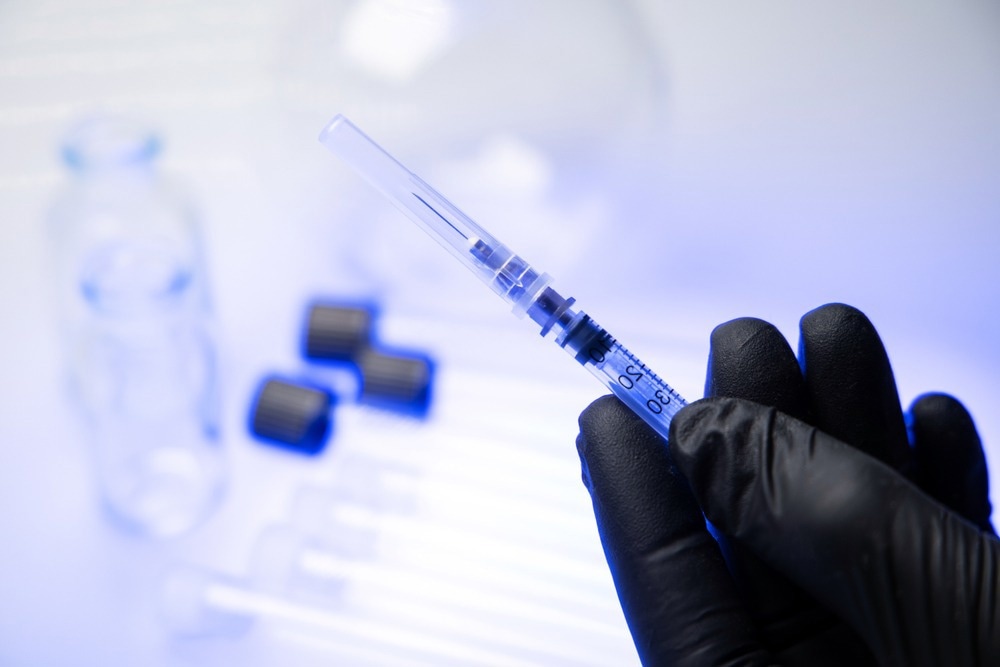Side effects associated with the coronavirus disease 2019 (COVID-19) vaccination have been reported in many countries. Thrombocytopenia is not uncommon; however, pneumonitis induced by vaccination is relatively rare, with only five cases that have been reported to date.
A recent Clinical Infection in Practice study presents the case report of a patient who developed pneumonitis and thrombocytopenia concurrently after being administered the COVID-19 vaccine. This study also summarizes previous cases of COVID-19 vaccination-associated pneumonitis and thrombocytopenia.
 Study: Thrombocytopenia and pneumonitis associated with BNT16B2b2 mRNA COVID-19 vaccine: A case report. Image Credit: Boumen Japet / Shutterstock.com
Study: Thrombocytopenia and pneumonitis associated with BNT16B2b2 mRNA COVID-19 vaccine: A case report. Image Credit: Boumen Japet / Shutterstock.com
About the patient
The subject of the current study was an 80-year-old Japanese man who experienced seven days of cough, fever, and shortness of breath. The individual also had a history of Behçet’s disease and hypertension but was not under any medication.
The patient quit smoking at 50 years of age; however, before that, he smoked about 30 packs each year. The patient’s body mass index (BMI) was 23 kg/m2.
Clinical presentation
The subject was vaccinated with the Pfizer-BioNTech BNT16B2b2 messenger ribonucleic acid (mRNA) COVID-19 vaccine. One week after receiving the first dose, he developed persistent chills for another week, following which he visited the family hospital.
At the hospital, the patient’s body temperature was 38°C and C-reactive protein (CRP) levels were 158.0 mg/L, which normally has a reference value of 1.4 mg/L. Both CRP and temperature levels eventually normalized. The patient subsequently received the second vaccine dose after three weeks of receiving the first.
The day after the administration of the second dose, the subject developed a fever of 37.8°C and exhibited a low oxygen saturation level of 85%. Further blood tests revealed elevated platelet and white blood cell counts. Additionally, CRP was 172.0 mg/L and D-dimer was 3.8 μg/mL, the latter of which has a reference value of less than 1.0 μg/mL.
Computed tomography (CT) images revealed the right upper lung to have an area of consolidation with air bronchograms. Ground-glass opacities were noted beside the pleura of the left lung, in addition to enlarged mediastinal lymph nodes. Pneumonia was determined to be the most likely cause of these developments.
Treatment
The patient received a diagnosis of community-acquired pneumonia and was subsequently treated with 2 g/day of ceftriaxone. The response was not satisfactory, which led the clinicians to then initiate levofloxacin and tazobactam/piperacillin treatment. Nevertheless, the fever did not subside, with CRP and blood cell counts remaining elevated.
A bronchoalveolar lavage (BAL) was scheduled for day 13 after admission; however, the procedure was not performed, as the patient exhibited reduced platelet counts. Immunoglobulin G (IgG), IgA, and D-dimer levels were elevated at 28.3 g/L, 7.0 g/L, and 1.8 μg/mL, respectively. CT images did not show any thrombus.
COVID-19 vaccination was suspected to cause both thrombocytopenia and pneumonitis. After this determination was made, prednisolone treatment, platelet transfusions, and intravenous Ig (IVIG) were initiated.
Platelet counts ultimately returned to normal after five days, thus allowing the prednisolone dose to be reduced after eight days. CT images after three weeks showed an improvement in lymph node appearance and pneumonia. After the completion of steroid tapering, the subject continues to do well and is periodically monitored.
Other COVID-19 vaccine-associated pneumonitis and thrombocytopenia reports
Five cases of vaccination-induced pneumonitis have been reported, with pneumonitis appearing within a few days of receiving the second vaccine dose in three of these cases. CT imaging results were similar to those reported in the current study, whereas BAL revealed elevated levels of lymphocytes in two patients.
Alveolitis with lymphocyte infiltration was also observed in one case. All patients responded well to steroid treatment.
COVID-19 vaccine-induced thrombocytopenia without thrombosis is common. The symptoms associated with this condition have been observed within one week of first-dose administration and treatment was initiated with steroids and/or IVIG. Some reports of thrombocytopenia with thrombosis have also been noted with unsatisfactory responses to steroid therapy.
Conclusions
The present study reported a case of pneumonitis and thrombocytopenia in a patient with Behçet’s disease after receiving the BNT16B2b2 mRNA COVID-19 vaccine.
The authors highlight the utmost importance of considering such case reports on the adverse side effects associated with COVID-19 vaccination. This data will ultimately aid in the appropriate management of COVID-19 patients worldwide during the ongoing pandemic.
Journal reference:
- Kojima, Y., Takeyabu, K., Satoh, M., & Konno, S. (2022) Thrombocytopenia and pneumonitis associated with BNT16B2b2 mRNA COVID-19 vaccine: A case report. Clinical Infection in Practice 16. doi:10.1016/j.clinpr.2022.100204